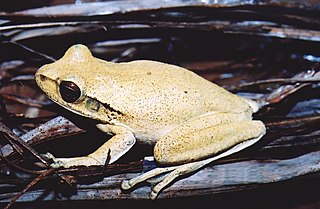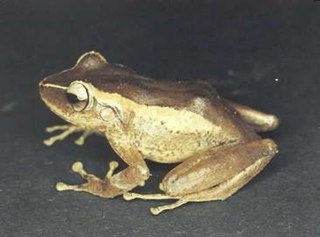
Karl Patterson Schmidt was an American herpetologist.

Microhyla ornata, commonly known as the ornate narrow-mouthed frog, ornate narrow-mouthed toad, or ornamented pygmy frog, is a species of microhylid frog found in South Asia. This amphibian is distributed in Kashmir, Nepal, peninsular India and the Andaman and Nicobar Islands, Sri Lanka, and Bangladesh. It was previously considered to be the same species as Microhyla fissipes; therefore, the aforementioned common names can refer to either species.
Mertensophryne schmidti is a species of toad in the family Bufonidae. It is endemic to Democratic Republic of the Congo and only known from the Upemba National Park.

Hallowell's tree frog is a species of frog in the family Hylidae.

The Chaco tree frog is a frog species in the family Hylidae found in Argentina, Bolivia, Brazil, Colombia, French Guiana, Paraguay, and Venezuela.
Legler's stream frog is a species of frogs in the family Hylidae found in Costa Rica and Panama. Its natural habitats are subtropical or tropical moist lowland forests, subtropical or tropical moist montane forests, and rivers. It is threatened by habitat loss.

The Ceiba stream frog is a species of frog in the family Hylidae endemic to Honduras. Its natural habitats are subtropical or tropical moist lowland forests, subtropical or tropical moist montane forests, and rivers. It is threatened by habitat loss.

Ololygon cardosoi is a species of frog in the family Hylidae. The specific name cardosoi honors Adão José Cardoso, a Brazilian herpetologist.
Afrixalus sylvaticus is a species of frog in the family Hyperoliidae. Its common name is forest banana frog or forest spiny reed frog.

Phlyctimantis maculatus is a species of frog in the family Hyperoliidae. They are silvery greyish-brown with dark brown to black spots, and derive their name from bright red coloring on the ventral side of their hind legs. Adult body length is typically 6 to 7.5 centimeters. These frogs have vertical pupils. Common names include red-legged running frog, brown-spotted tree frog, red-legged Kassina, red-legged pan frog, spotted running frog, tiger leg running frog, and vlei frog.
Crossodactylus schmidti or Schmidt's spinythumb frog is a species of frog in the family Hylodidae. It is found in Argentina, Brazil, and Paraguay. Its natural habitats are subtropical or tropical moist lowland forest and rivers. People have seen it between 300 and 750 meters above sea level. It is threatened by habitat loss.

Eleutherodactylus portoricensis is a frog native to Puerto Rico that belongs to the family Eleutherodactylidae. Its vernacular English names are forest coquí,upland coquí, mountain coquí, and Puerto Rican robber frog. The species’ range spans the Luquillo Mountains of northeastern Puerto Rico and the Cordillera Central, which forms the highland “backbone” of Puerto Rico and includes an eastern extension beginning at the city of Cayey. However, the species is likely extirpated from the western Cordillera Central.
Telmatobius simonsi is a species of frog in the family Telmatobiidae. It is endemic to Bolivia. Its natural habitats are subtropical or tropical moist montane forest, subtropical or tropical high-altitude shrubland, subtropical or tropical high-altitude grassland, rivers, freshwater marshes, arable land, pastureland, rural gardens, heavily degraded former forest, ponds, and canals and ditches. It is threatened by habitat loss. It was named for American scientific collector Perry O. Simons.
Oreolalax schmidti is a species of amphibian in the family Megophryidae. It is endemic to China where it can be found in the Hengduan Mountains in western Sichuan and northern Yunnan provinces. Its natural habitats are temperate forests, subtropical moist shrubland, rivers, swamps, and freshwater marshes. It is threatened by habitat loss. It is named after Karl Patterson Schmidt, American herpetologist.

The painted chorus frog, also commonly known as Butler's narrow-mouthed toad, Butler's pigmy frog, Butler's rice frog, Butler's ricefrog, noisy frog or tubercled pygmy frog, is a species of frog in the family Microhylidae. It is found in northeast India, Myanmar, southern China, Hong Kong, Taiwan, Thailand, Cambodia, Laos, Vietnam, Peninsular Malaysia, and Singapore. Its natural habitats are subtropical or tropical moist lowland forest, subtropical or tropical moist montane forest, subtropical or tropical moist shrubland, swamps, intermittent freshwater marshes, arable land, plantations, rural gardens, ponds, open excavations, and irrigated land. It is not considered threatened by the IUCN.

Amnirana darlingi, commonly known as Darling's golden-backed frog, is a species of frogs in the family Ranidae. It is found in eastern Angola, the Caprivi Strip of Namibia, extreme northern Botswana, extreme southern Democratic Republic of the Congo, Zambia, eastern and northern Zimbabwe, southern Malawi, and west-central Mozambique.
Cornufer schmidti is a species of frog in the family Ceratobatrachidae. It was first described as a subspecies of Platymantis papuensis. It is the type species of the subgenus Aenigmanura within Cornufer. It is endemic to the Bismarck Archipelago, Papua New Guinea, and is known from the islands of New Britain, New Ireland, and Manus; the Manus population might represent a distinct species.

Vaillant's frog is a species of frog in the family Ranidae found in Central America. Its natural habitats are subtropical or tropical dry forests, subtropical or tropical moist lowland forests, subtropical or tropical swamps, rivers, swamps, freshwater lakes, intermittent freshwater lakes, freshwater marshes, intermittent freshwater marshes, rural gardens, heavily degraded former forests, water storage areas, ponds, and canals and ditches.

The harlequin tree frog is a species of frog in the family Rhacophoridae found in Brunei, Indonesia, Malaysia, Thailand, and the Philippines. Its natural habitats are subtropical or tropical moist lowland forest, subtropical or tropical moist montane forest, freshwater marshes, and intermittent freshwater marshes. It is threatened by habitat loss.

Hylarana macrodactyla is a species of frog in the family Ranidae. It is also known as the Guangdong frog, three-striped grass frog and the marbled slender frog.














